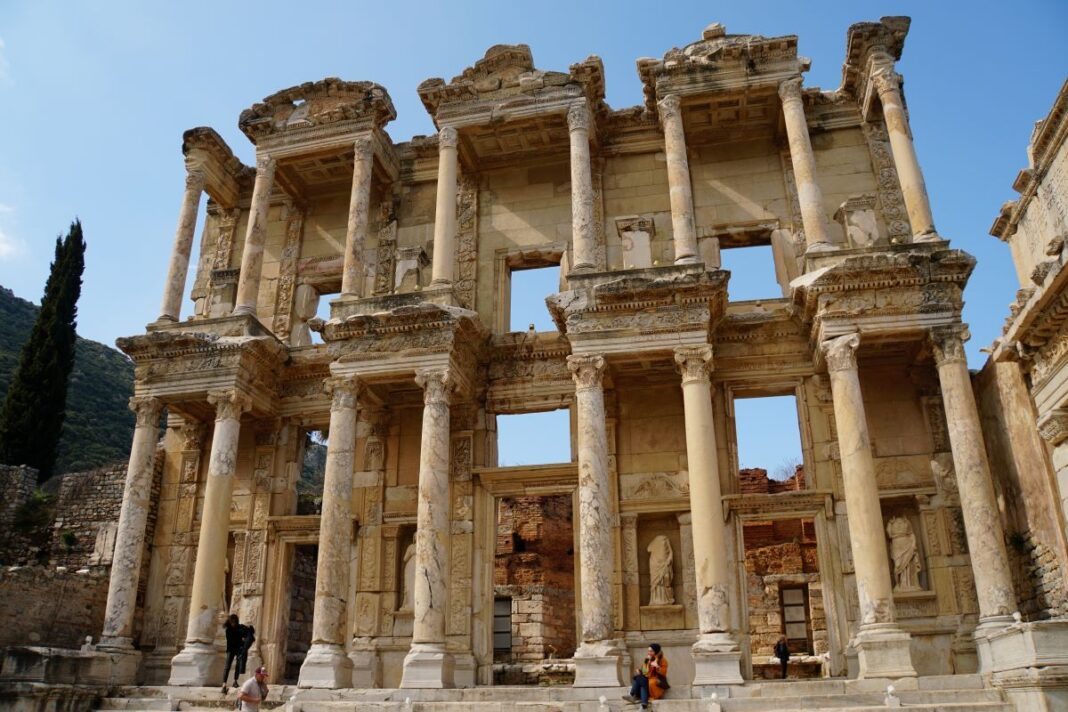After Izmir, where we enjoyed our first week in Turkey, we are now in Kusadasi for seven days. We are looking forward to exploring this city and the surrounding sights. One of the destinations that top our list is Ephesus, the once Roman capital of euro Asia. Our post, “An Amazing Guide For Ephesus And Ruins Nearby,” is written to provide useful travel information to you, the reader. We will highlight the areas to visit and relay our own experiences.
Guide For Selcuk: Ephesus Awaits
Our trip to Ephesus started with catching a dolmus (DOHL-moosh) to the downtown bus station, then transferring to another dolmus (minibus) that would take us to Selcuk. Ephesus is about three kilometers before Selcuk you need to request to be dropped off as the Dolmus does not go directly into Ephesus. Once dropped off, it’s a half Km walk to the entrance of Ephesus from the main road.
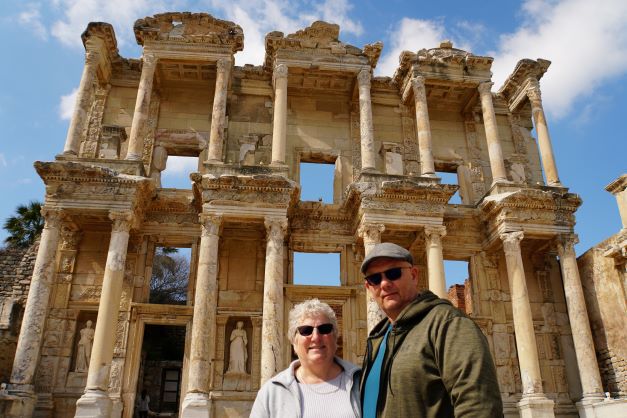
Lower Gate Ephesus (map)
After reaching the lower entrance gate, we purchased tickets to enter Ephesus including visiting the Terrace Houses. Just before entering Ephesus, we were approached by a guide, who offered his services. He told us the going rate was 250TL per hour, and that it generally takes two hours to walk through the Ephesus. While researching Ephesus, we read that using a guide was best as there was so much to see, learn, and understand. We hired him with no hesitation, we found out later that Tek (our guide) had 50 years of experience. We would recommend hiring a guide as their knowledge is essential to making the experience here memorable.
Harbor Street
A short walk into Ephesus from the lower gate, you come across Harbor Street, 500 meters long, and runs from what was the harbor to the stadium. Harbor street was the main street used by all who came to Ephesus, from Emperors to the commoner, including sailors. Everyone entering Ephesus had to enter through the bath to be cleansed from diseases before being allowed into the city. Harbour Street had columns on each side that had lanterns attached to them, at night they would be lit (using olive oil), lighting the way. Merchant shops lined this street, selling their wares.



Ephesus The Grand Theater
Heading up Harbor Street and at the end, you will find The Grand Theater, a magnificent structure located on the slope of Panayir Hill. The Grande Theater was first constructed in the third century BC; then enlarged to its current form during the Roman Period. The theater has a capacity of 25,000 seats, made up of sixty-six rows, divided by two staircases between seats and three tall horizontal sections.




The stage building is three stories tall and its facade facing the audience was ornamented with relieves, columns with windows, and statues. Five doors are opening to the orchestra area, the middle of which is wider than the rest. The Grande Theatre was used for concerts, plays, and religious, political, and philosophical discussions.
Marble Street
Marble Road runs from the Grande Theatre up to the Celsus Library. As we worked our way through Ephesus up towards the top entrance, Tek was very good at taking the time to explain all the buildings, ruins, roads, and everything else along the way. As a matter of fact, there was this one particular oddity that Tek referred to as the first billboard advertisement ever.
I will explain what this particular inscription in the stone pictured below tried to convey to the passer-by. Taking a look at the bottom of the picture; there is a box representing money. The second picture above the box represents a beautiful woman (queen). To the left is afoot which indicates walking as well as your age, and just above that is directions, straight ahead and then to the left. Above the directional sign and to the left a heart. Above the heart and to the right is a hole. Now put all this together:
If you have money and desire a beautiful woman, old enough, walk up the road, and to the left, you will find love, and she only accepts cash.
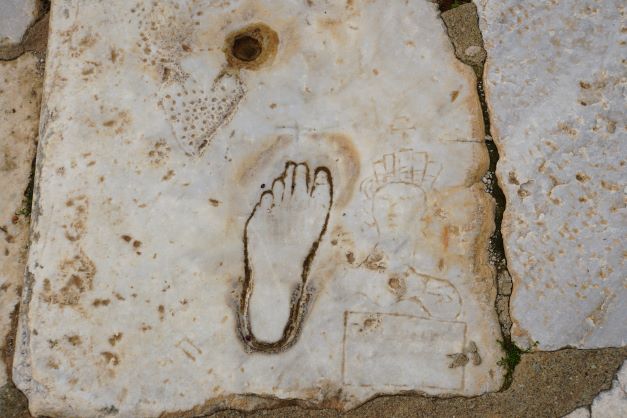
Celsus Library
The Celsus Library is an incredible sight with a facade that stands tall, with amazing detail, and impressive statues. The incredible beauty of this building is worth every picture that has been taken, and there have been many. I’m sure, the most photographed building in Ephesus. There were only a half dozen people around when we were there, which made for some stunning pictures.
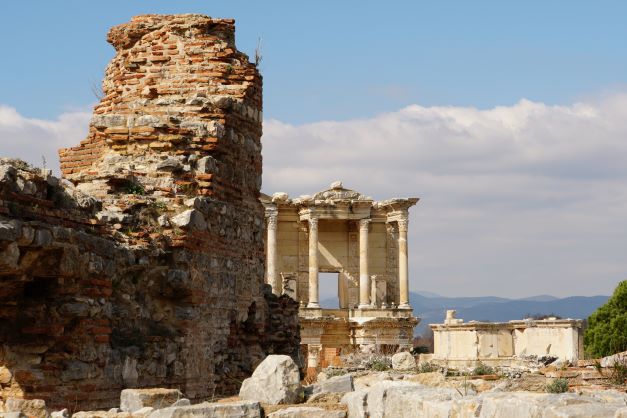
The Celsus Library, built-in 117 AD, was a monumental tomb for Gaius Julius Celsus Polemaeanus, the governor of the province of Asia. Celsus’ grave is beneath the ground floor, across from the entrance and Athena’s statue was placed over it because Athena was the goddess of wisdom.





The scrolls and manuscripts were kept in cupboards against the walls, there were double walls behind the bookcases to prevent extremes of temperature and humidity. The library’s capacity was more than 12,000 scrolls and was the third richest library in ancient times after the Alexandra and Pergamum.
Terrace Houses
To enter the Terrace House, you need to have purchased a ticket along with your Ephesus ticket. We found these houses extraordinary as they give the visitor a glimpse of what life would have been like for the very wealthy. You can only imagine what life as a commoner would have been like. Simply fascinating to discover that these homes were heated and had hot and cold water running as well. The pictures painted on the walls of these homes are gorgeous, as are the tiled floors, ah if only to be rich.



Ephesus terrace houses are located on a hill, opposite the Hadrian Temple. There are six residential units on three terraces at the lower end of the slope of the Bulbul Mountain. The oldest house dates back to 1C BC and continued to be used as a residence until 7C AD. Today these houses are covered with protective roofing, which resembles the past. The houses had interior courtyards in the center, with the ceiling were open. Primarily two-storied; the upper level has collapsed over time. There were living and dining rooms opening to the hall on the ground floor, and upstairs there were bedrooms and guest rooms.





The heating system of the terrace houses was the same as that found in the baths. Clay pipes beneath the floors and behind the walls carried hot air throughout the house. The homes also had cold and hot water. The rooms had no window, only illuminated with light from the open hall, so most of the rooms were dim.
The Public Toilets
Cindy and I found The Public Toilets to be very interesting as we would have never thought that way back then, such modern plumbing systems existed. The toilets were part of the Scholastica Baths built in 1C AD. There was an entrance fee to use them. In the center of the room, there was an uncovered pool, and the toilets are aligned along the walls. The columns surrounding the pool supported a wooden ceiling.
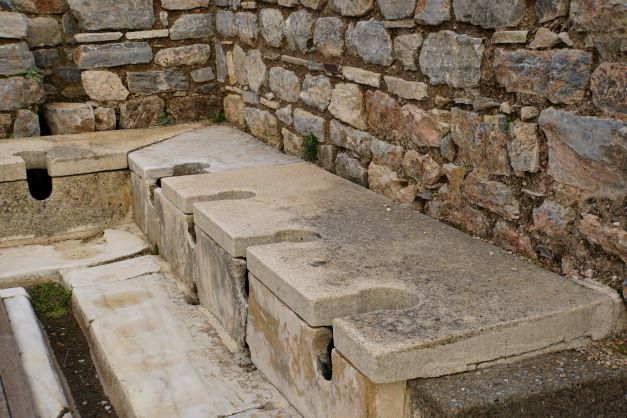
A series of 36 holes designed to handle your business stretch across three long benches and a trough with relatively clean water would be flowing sits near your feet. Running water in the channel was used to dampen the sponge on a stick for personal cleansing and then to rinse off the sponge after use. In the absence of running water, a bucket of salt or vinegar water would be used, much to the irritation of everyone’s nether regions.
Final Thoughts On Ephesus
We enjoyed our visit to Ephesus; it is a fascinating place and very large in scope. We had a guide and went from bottom to top, as I mentioned earlier, which took us two hours, our guide left, then we worked our way back down again; in total, our visit lasted 5 hours, and we took over 600 pictures. I’ve read from many others to start at the top and work your way down, I think what we did is better, but it depends on your interest and how much time you have. Or how busy the place is.
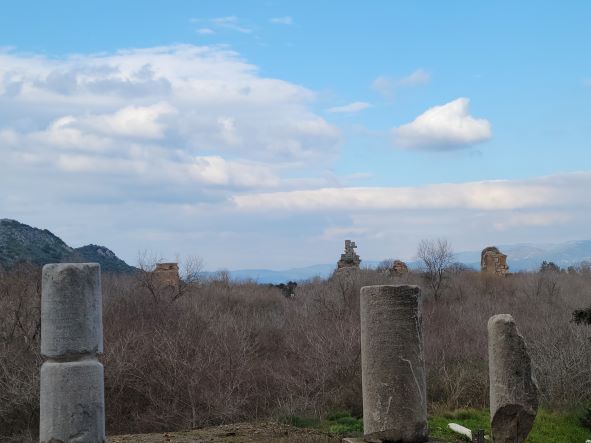
I have talked about Ephesus this is a tiny part of what you will see here in Ephesus. If given the opportunity, you should make every effort to visit. I would recommend in the offseason or the shoulder as this place is very popular and can get very hot in the summertime.
How To Get To Ephesus
There are several ways to get to Ephesus to tour these magnificent ruins. You could be part of a tour from the surrounding area, most likely Kusadasi, as cruise ships dock here. There is the option of hiring a taxi and having them wait for you while you’re touring the ruins. Lastly, you can do what we did catch the Dolmus from Kusadasi out to the ruins.
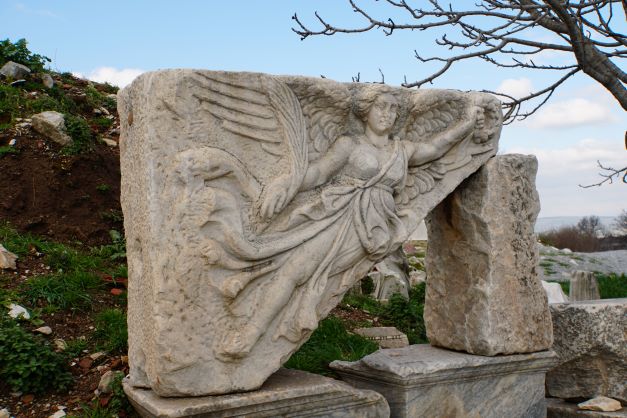
Getting To Ephesus Using A Tour Company
Many tour companies operate in Kusadasi; I’ll be honest, I do not know the going rate. Positives would be that you are picked up at your hotel and then driven to Ephesus with a group of other like-minded individuals. You have a tour guide that will explain to you all about Ephesus. The downside would be the high cost, of working with someone else’s schedule. You bring your own crowd in a group of people, so pictures are hard to take; you may miss out on information that your guide is trying to talk to you about as others may not be that respectful.
Hiring A Taxi To Get To Ephesus
Walking around Kusadasi, you will find many taxis for hire that will drive you to Ephesus, wait up to three hours, and then bring you back to town. The positives to this form of transportation are that you are a small group and can share the cost of the taxi. You are not working with someone else’s schedule so that you can tour the ruins at your own pace. Two main downsides to the taxi are the cost of 50 euro, and ultimately you are working with the taxi’s schedule or paying a higher fee for his wait time. You have no guide, but you can hire one if you wish.
Catch The Dolmus To Ephesus
Using the dolmus was our choice as the cost was the most significant positive to this option; we paid 17 TL in total to get to the ruins from Kusadasi. You have your own schedule, tour as long as you want, and do whatever you please, not part of any crowd. The downside to this last option is not knowing the bus schedule, pickup, or drop-off points.
How To Catch The Dolmus
Catching any dolmus in Kusadasi is a 4 TL cost, it will end up taking you to the Dolmus bus station in the town center. Once you arrive here, you will need to wait for the bus that says Selcuk on the sign; it will also say Kusadasi to Selcuk. People at the bus stop will assist you as well if needed. Once you catch the bus, you need to tell the driver that you want off at Ephesus, then pay the 13 TL for the ride. Once he drops you off at the roadside to Ephesus, it is about a 500-meter walk to the gates.
To return to Kusadasi, you can wait for the Dolmus on the other side of the main road from Ephesus or catch the return Dolmus bus from the Selcuk central bus station. Taking a Dolmus may look complicated, but it is straightforward.
Guide For Antiquities Nearby Ephesus (map)
Selcuk has lots to do and see for being a much smaller town than Kusadasi. Selcuk attractions can be visited over two days, and most are within walking distance. Except for House of Mary, which I think is 8 kilometers away. To visit this, you will need to hire a taxi, the cost is 180 TL.
Admission Fees / Entry Ticket Costs for Ephesus and the nearby Attractions
- Ephesus: 120 Turkish Lira
- House of Mary: 80 Turkish Lira
- Temple of Artemis: Free of Charge
- Isa Bey Mosque: Free of Charge
- Terrace Houses: 40 Turkish Lira
- Basilica of St. John: 30 TL
- Museum of Ephesus: 30 TL
Guide For Selcuk: Basilica Of Saint John (map)
The early Christian community in the ancient port city of Ephesus traced its origins to the apostle and evangelist St. John, the Beloved Disciple. According to the church, John wrote his gospel in Ephesus, and, after a period of exile on the island of Patmos, John returned there and died.
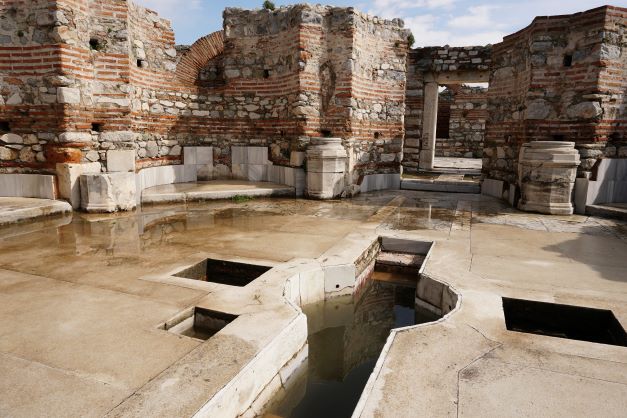
The Basilica Of Saint John’s primary attraction is St. John’s tomb and its marble encasement, still visible today. History says that when Constantine opened the saint’s tomb, no relics were found, attesting to the saint’s miraculous assumption into heaven.





On visiting the Basilica of Saint John we were completely amazed by the sheer size of the site and the condition that it was in. Definitely worth visiting. I confess that I did not know that early Christianity was so intertwined with the Roman settlements of Turkey. I assumed everything centered around Israel. It’s good to learn something. I believe that we spent an hour or a little longer walking through the site.
The site is open from 8 a.m. to 6 p.m. April to October and 8 a.m. t.o 4 p.m. November to March.
Guide For Selcuk: Ayasuluk Citadel (map)
Ayasuluk Citadel or the acropolis was built by the Byzantines, although the exact date of construction is unknown. Findings of Mycenaean pottery and other artifacts found here, it is thought that indigenous Anatolian people used the acropolis before the arrival of the Ionian Greeks around 1000 BC. The Turks rebuilt and added to the Citadel, which has 15 watchtowers and contains numerous cisterns, the remains of a Byzantine church, and a small mosque.





The Ayasuluk Citadel is located past the Basilica of Saint John, by a ten-minute walk. The cost is covered by the entrance fee paid to enter the Basilica. The Citadel was renovated in 2008, so it is in excellent shape. There are a couple of interesting buildings inside the castle walls: an old church and a mosque. If you are visiting the Basilica of Saint John, you should also take the extra time to visit the castle. It will take an additional 45-60 minutes, including the walk.
Guide For Selcuk: İsa Bey Mosque ( map)
Just down the hill from the Basilica of Saint John, you will find İsa Bey Mosque, dating back to 1375. Its design resembles the works of Arabic masters rather than the more familiar Ottoman mosques, which did not take shape until after the Ottoman conquest of Constantinople in 1453. In 1653 and 1668, the İsa Bey’s two minarets suffered damage from earthquakes.



The Mosque stood in ruins for quite a while, but in 1975 it was restored and reopened for prayer. Further restorations were carried out in 2005. The Mosque is used for worship, visitors can visit. Before entering read and follow the rules posted, then enter and enjoy the architecture.
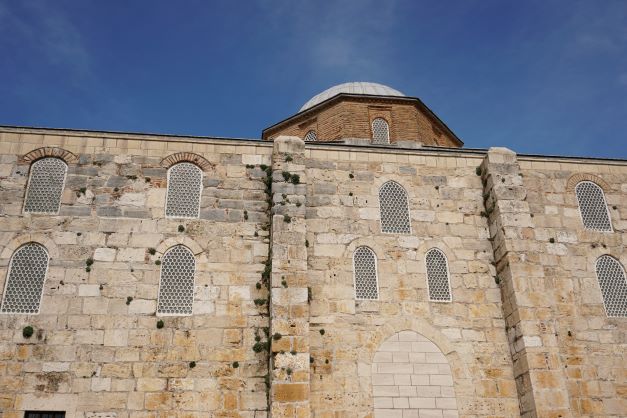
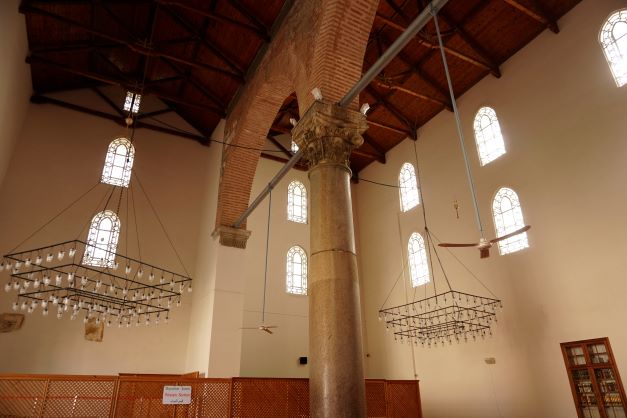
During our visit to the Mosque, the Imam came over and talked to us; his English was good. He took the time to ask us about our trip and what we thought about Turkey, its people and culture. After which, he explained a little about the Muslim faith and the Quran to us. We had a lovely conversation; he allowed us to take pictures and observe their prayer. Before we left, he handed us a copy of the Quran with his business card and email if we had any questions. A gratifying experience, I might add. I would highly recommend visiting; it takes all of a half-hour.
Guide For Selcuk: The Temple OF Artemis (map)
After visiting the İsa Bey Mosque, we walked toward the Temple of Artemis. Along the way, we found an old Turkish bath that was fenced off but dates back to 1350. It looked interesting enough; maybe someday they may restore it as well.
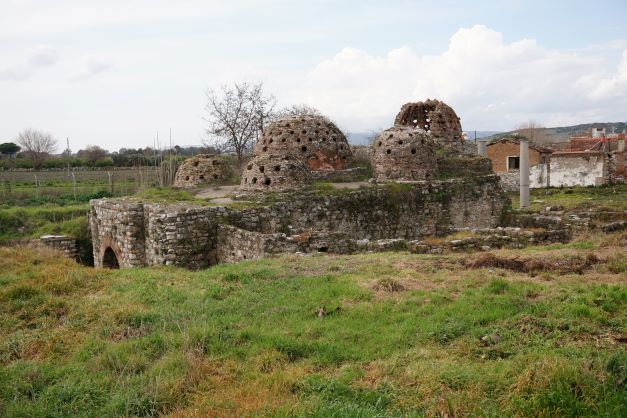
The Temple of Artemis is known as one of the Seven Wonders of the ancient world. Built-in the areas of Ephesus on a flat site. Over the centuries this location has turned into a swamp. If you visit the Temple, there is not much to see except a solitary column standing. The most beautiful remains of this temple are today exhibited in the London British Museum.
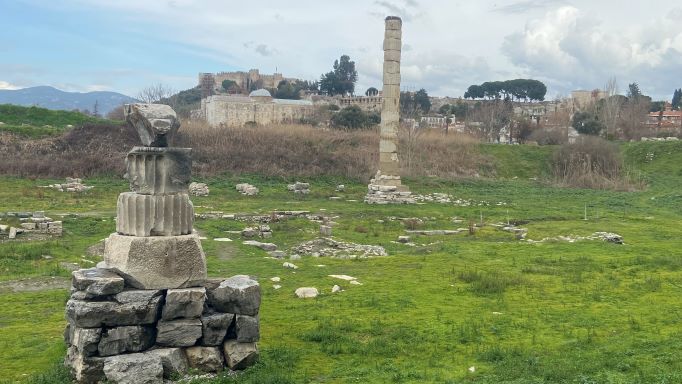
The statue of the many-breasted Artemis was the symbol of the Temple but also of abundance, hunting, and wildlife. The genuine statue of Artemis today can be visited at the Ephesus Museum, and it takes ten minutes to walk to maybe 10 minutes there.
Guide For Selcuk: Ephesus Archaeological Museum (map)
In this small but well-organized museum, there are findings from the excavations at Ephesus archeological site, and artifacts from the Cukurici Mound, the Basilica of St John, and the Temple Artemis can be found here as well. You can find a comprehensive collection of coins dating back to when money was first used in history.
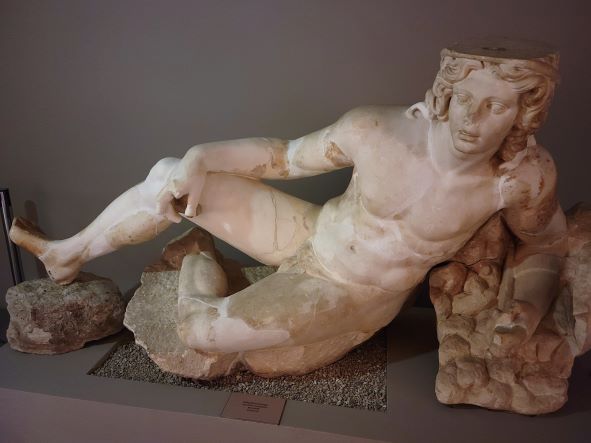
Before visiting these galleries, you should not miss the 3D simulation video of ancient Ephesus. Here visitors can visualize the setting of the ancient city and what the buildings used to look like. The video is in Turkish, English, and German, lasting 10 minutes. The video room is the first room before the fountain statues gallery, and this would have been nice to know when we visited.





One of the most remarkable artifacts in the museum is the statue of Artemis, the Priapos statue, the head of Socrates, the Egyptian priest, and the oldest piece – a stamp- found in Cukurici Mound- dating back to 6200 BC.



The Ephesus Archaeological Museum is located not that far from the town center, an easy walk from just about anywhere. The museum takes between 60-90 minutes to go through. We felt that the museum was well laid out and worth the visit. We visited before going to Ephesus, not sure if that makes a difference or not.
Interesting Note About The Antiquities From Ephesus
In Ephesus, the archeological artifacts dug between 1867-1905 were transported to the British Museum; and artifacts from 1905-to 1923 were taken to Vienna. With the founding of the New Turkish Republic, the government forbade taking antiques out of the country and required the artifacts taken outside the country back to Turkey. In 1964, the Ephesus Museum was founded, and the findings from the excavations at Ephesus archeological site and around were put into this museum.
Guide For Selcuk: Grotto Of The Seven Sleepers (map)
After we had finished touring the ruins of Ephesus, we decided to visit the Grotto Of The Seven Sleepers, which would be about a three-kilometer walk. It was a lovely day for a walk, so following the road, we were able to find the location of the Grotto Of The Seven Sleepers. There are several signs indicating direction along the way.





Once there, you pass through a gate and follow the path, maybe 400 meters to the location. The area is fenced and gated, so it isn’t easy to see much or explore. We ended up taking some photographs of what we could see and left somewhat disappointed. We still had another 3 kilometers to walk before we reached Selcuk. It had been a long day, putting on nearly 25,000 steps. Not sure if I would recommend visiting, but we had not much else to do.
Guide For Selcuk: House Of The Virgin Mary (map)
The House Of The Virgin Mary is where Mary may have spent her last years. Unfortunately, we did not have the time to visit. I would have liked to, but it just was not meant to be. Mary may have come to the area with Saint John, who spent several years spreading Christianity. Mary preferred this remote location rather than living in a crowded town.
The house of the Virgin Mary is a typical Roman home made entirely of stones. In the 4th century AD, a church was built that encompassed the home. The original two-stored house consisted of an anteroom (where today candles are proposed), a bedroom and praying room, and a room with a fireplace (chapel for Muslims). Today, only the central part and a room on the right of the altar are open to visitors. One can understand that this building looks more like a church than a house.
Guide For Kusadasi What To See And Do
We visited Kusadasi near the end of February, so, unfortunately, we were not able to discover all the things that Kusadasi is known for. In saying that, we will try to provide you with somewhat of a guide for Kusadasi. Firstly, Kusadasi is a busy city situated on the Agean coast so beaches are plentiful and I’ve read very lovelily.
Ladies Beach
Ladies beach is a fifteen-minute walk from downtown or a short minibus ride from downtown. The beach is a kilometer of soft sand on a west-facing bay. The name “Ladies Beach” is a holdover from the Ottoman days of segregation. Thanks to a smooth slope and a large shallow area where non-swimmers can play, this is a beach for families. Ladies beach is a popular place to spend a warm afternoon, and there are beach clubs all around the bay, renting out sun loungers and parasols. The promenade, full of restaurants, cafes, and shops, is set slightly above the beach and has a seriously romantic view across to Samos at sunset.
Kuşadası Harbour
Cruise ships dock here, maybe not so many lately, but I’m sure they will be back. The town comes alive when these floating cities come calling. The harbor area is busy with activity, shops that sell whatever you might or might not need, and Restaurants aplenty to enjoy food and drinks with new or old friends. Near the cruise ship dock, you will find lots of seafood restaurants along with a fish market, so if you are looking for the catch of the day, you do not have to look far. The fish is tasty, and the beer is always cold, or indulge in some Turkish Raki that can be found pretty much everywhere.





If you’re up for a day trip to the Greek island of Samos, this is the place to embark. You can find boat tours on the causeway at pigeon island that will take you out to get a different perspective of Kusadasi. There is always something going on down by the harbor, so join in. You will find a sculpture of hand-releasing doves roughly halfway along the Boulevard.
Gazibegendi Hill
Northeast of the marina, there’s a hill that oversees the city; this spot is the best lookout in Kuşadası, especially at sunset. Gazibegendi Hill commemorates Turkey’s modernizing statesman Mustafa Kemal Atatürk (1881-1938), who came here in 1924 and 1937. The name Gazibegendi means “Loved by the Veteran,” Atatürk’s nickname.
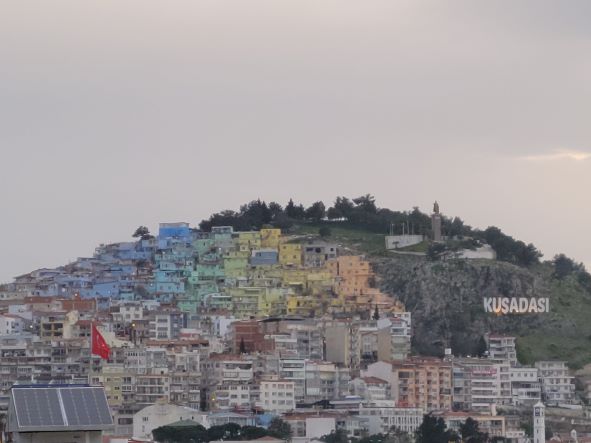
The story goes that he was especially taken with the view of the indented Aegean coastline from this vantage point. To honor him, there’s a Turkish flag and a bronze statue of Atatürk contemplating the vista down to Güvercinada.
Güvercinada (Pigeon Island) (map)
Güvercinada Castle was built to protect the harbor at the mouth of Kuşadası Bay. There is an inner castle built-in 1470’s ish with the outer built by İlyas Ağa on Güvercinada in 1826. During the Peloponnese Rebellion, these walls were built to prevent islands and sea attacks. The walls were made about 3 meters high to surround the island. The stones used in the construction of the castle were brought from Yılancıburnu. To the south of the walls is the castle’s entrance gate, protected by two towers and a round arch. The north tower is pentagonal, and the south tower is cylindrical.





The castle is a short walk from the downtown area. We did visit and enjoyed our time there, peaceful and beautiful. It does not take long to walk through, so we recommend visiting if you have some spare time and are looking for something to do. There are boat tour operators along the causeway that leads out to the castle, tours are inexpensive, 30 TL for an hour.

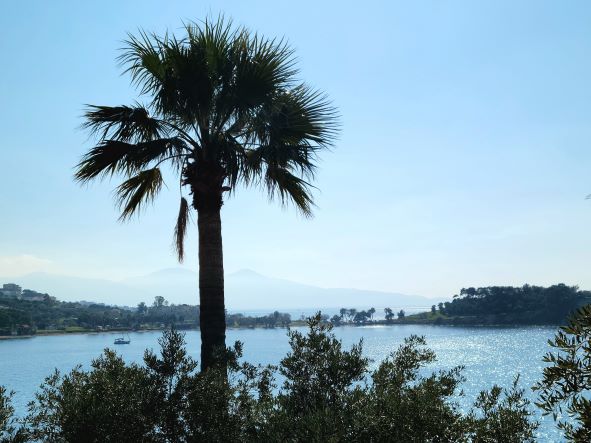
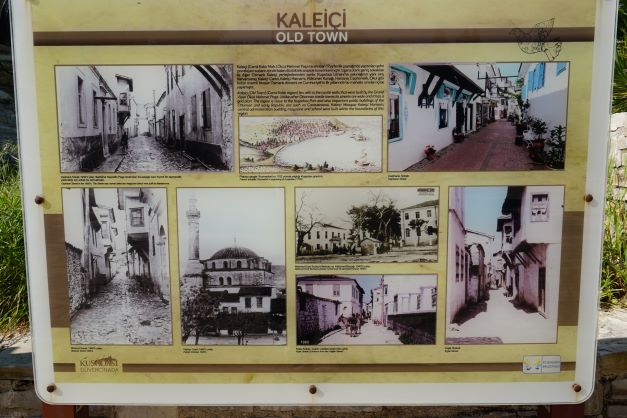
Our Time Spent Here In Kusadasi
We spent a lot of time walking the downtown area of this city. We found Kusadasi to be a friendly town with a little bit for everyone. If you get off the main street, you will find lots of souvenir shops selling their wares. After which, look for inexpensive local restaurants serving up local favorites and very tasty, at that I might add.





The central Boulevard is pleasant to walk down as there are lots to see, including the harbor with all the boats to specialized shops that await your money. There seems to be always something going along the Boulevard.
Our Accommodations While In Kusadasi
While we were in Kusadasi we stayed at an Airbnb, Pine City Residence 2BR, our host was very good and responded quickly to any requests or questions that we had. He arranged to have a taxi pick us up when we left to take us to the train in Selcuk. So if looking for a taxi driver Mr. Necati speaks English and can be reached on Whatsapp +90 507 920 47 43. The apartment itself was very comfortable and had a beautiful view. Located close enough that we could walk into town but far enough away that you never had a problem with noise. Everything that you might need it has, we stayed 7 days.
Chronological Timeline Of Turkey
| Paleolithic Age (Early Stone Age) 60,000 – 10,000 BCE | Mesolithic Age (Mid Stone Age) 10,000 – 8,500 BCE |
| Neolithic Age (Late Stone Age) 8,500 – 5,000 BCE | Chalcolithic Age (Copper Age) 5,000 – 3,000 BCE |
| Bronze Age 3,000 – 2,000 BCE | Hatti and Hurrian Civilization 2,500 – 2,000 BCE |
| Troy – II Settlement 2,500 – 2,000 BCE | Hatti and Hittite Principalities Period 2,000 – 1,750 BCE |
| Great Hittite Kingdom Hurri Civilization 1,750 – 1,200 BCE | Troy – VI Civilization 1,800 – 1,275 BCE |
| Aegean Migration and Invasion From Balkans 1,200 BCE | The Anatolian Principalities during the Iron Age 1,200 – 700 BCE |
| Urartu Civilization 900 – 600 BCE | The Civilization of Phrygia 750 – 300 BCE |
| Lydia, Caria and Lycia Civilizations 700 – 300 BCE | Ionian Civilization 1,050 – 300 BCE |
| Persian Conquest 545 – 333 BCE | Hellenistic And Roman Age 333 BCE – 395 |
| The Byzantine Civilization (Eastern Roman Empire) 330 – 1453 | The Seljuk Empire 1071 – 1300 |
| The Ottoman Empire 1299 – 1923 | The Republic of Turkey Since 1923 |
How To Apply For Turkey eVisa
The Electronic Visa (e-Visa) Application System allows visitors traveling to Türkiye to quickly obtain their e-Visas online (www.evisa.gov.tr) in approximately three minutes. It is possible to obtain e-Visa 7/24 everywhere with an internet connection. After filling in the necessary information concerning their identity, passport, and travel dates, the applicants can obtain their visa and pay the visa fees online. It truly is that easy; We would recommend having a printed copy as well, just because.
Our Final Thoughts “An Amazing Guide For Ephesus And Other Antiquities Nearby”
- We really enjoyed our time in Selcuk and Kusadasi, there are so many things to keep you busy. This place has ancient ruins in spades, all are fascinating and worth the time to visit. We stayed in Kusadasi but spent two very full days in Selcuk as this is where most ruins are to be found. We used the dolmus to get around from town to town. I have written how to get there up above, this is by far the best way to get around and the cheapest. It only takes one ride to get comfortable with using them.
Our Positives
- Kusadasi is a beautiful city set right on the water’s edge, a cruise-ship port whenever they get running again.
- There are many food options to be found in both Kusadasi and Selcuk, but with Kusadasi, there are more options and greater seafood choices.
- Selcuk has so many places to visit that are in town or a short drive away, Ephesus is the biggest draw but there are many others as well.
- Kusadasi offers many beaches nearby, for us at the time of year this really was not an option.
Our Negatives
- If we had any negatives it might be the length of stay. For us free time is nice as we work on our blog. I think that 5 days in this area would be plenty to see the sights and enjoy the water. My thoughts anyway.
Would have, Could have, Should have
- What we might have done differently is booked in Selcuk as there is so much to do. You could easily spend 3 days here and never be bored. Our stay in Kusadasi was 7 days so its hard to say that would be a good idea to stay in Selcuk. My recommendation would be if you are staying in the area for 3 days or less Selcuk would be the way to go. If your stay is longer best bet would be to stay in Kusadasi especially if you are here when you can enjoy the beaches.
Next Stop
Cindy and I, and my sister, are taking the train (3hr ride) to visit Pamukkale, a town in western Turkey known for the mineral-rich thermal waters flowing down white travertine terraces on a nearby hillside. We have read plenty about this spot, so we will keep our fingers crossed. A place with so much hype will be hard for it to live up to its expectations. Hierapolis, an ancient Roman spa city founded around 190 BC, is located alongside the pools. The Antique Pool is famous for its submerged Roman columns resulting from an earthquake many years ago.
We have a whole itinerary planned for Turkey as we are spending two months here. Bouncing around the country, exploring what Turkey has to offer. We are excited and looking forward to this next leg of our trip as there is lots of history to dig into. Plus the Aegean coast, the sea, and many other delights and adventures, I’m sure.
Support Our Blog And It’s Unique Travel Content
You can support our site by using the links through our travel Essential. If you purchase items using our links, we will receive a small commission. There are no extra or hidden costs to you. These commissions assist us in our travel, so we can provide unique content to you through each blog post. If you enjoy our blog and find it interesting and informative please share it with friends. Subscriber, so you never miss a new post. Thank you.
Recommended Travel Essential
Cindy and I call ourselves nomadic, so we use certain essentials to make this way of life easier and more comfortable with our lifestyle. With this in mind, we have composed a list of what we feel are essentials and some tips you might use to plan or take your next travel adventure.
- Travel Packing Essentials to help organize and make this task less stressful
- Travel Safety Essentials to make your life on the road a little safer, giving you peace of mind
- Living essentials to make life a little more comfortable, be this resting, working, or playing.
Accommodation Options While Traveling The World
- Booking.com is one of our go to’s when we are looking for a place to stay for a couple of days or longer
- Agoda.com we find is best best to use when in Southeast Asia, but hey you never now what you might find
- Airbnb.com usded to be our go to but some of their cancelation policies are resonable, give them a try as well
Travel Insurance
We always travel with travel Insurance, just medical or complete trip coverage. We use Heymondo as we find their costs reasonable. Remember, don’t travel, and without coverage, the savings are not worth the possible costs.
Some links on this page are affiliate links, meaning if you buy a product using our link, we may earn a commission. This commission comes at no additional cost to you. Disclaimer.
